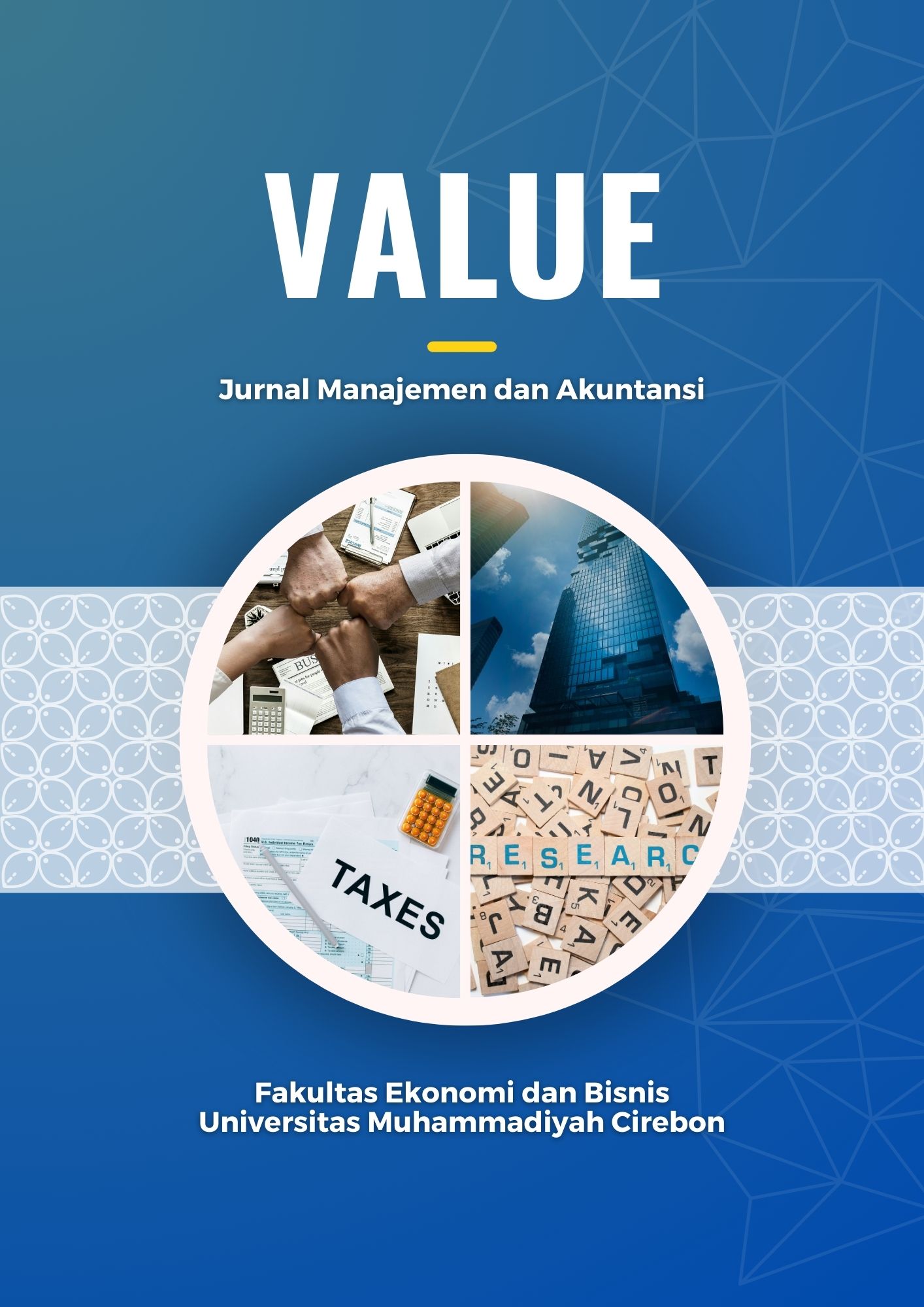Hambatan dalam Adopsi Layanan Online Perbankan pada Mahasiswa Akuntansi: Structural Equation Modeling
DOI:
https://doi.org/10.32534/jv.v20i1.7004Keywords:
Image Barrier, Value Barrier, Risk Barrier, Tradition Barrier, Barrier to The Usage of Mobile BankingAbstract
In the era of modern technological development, banking companies in Indonesia innovated by creating mobile banking technology to facilitate financial transaction services. In contrast, Although mobile banking provides convenience for its users, there are still many barriers for customers to use mobile banking. This study aims to identify barriers to the adoption of mobile banking technology. This research uses quantitative methods. The sample in this study were 101 Indonesian accounting students. The data analysis technique in this study used Structural Equation Modeling (SEM). The results of this study indicate that the image barrier and value barrier affect the barrier to the usage of mobile banking. while the risk barrier and tradition barrier have no effect on the barrier to the usage of mobile banking.
References
Anggita, E. D., Hoyyi, A., & Rusgiyono, A. (2019). Analisis Structural Equation Modelling Pendekatan Partial Least Square dan Pengelompokan dengan Finite Mixture PLS (Fimix-PLS) (Studi Kasus: Kemiskinan Rumah Tangga di Indonesia 2017). Jurnal Gaussian, 8(1), 35–45. https://doi.org/10.14710/j.gauss.v8i1.26620
Arif, I., Afshan, S., & Sharif, A. (2016). Resistance to Adopt Mobile Banking in a Developing Country: Evidence from Modified TAM. Journal of Finance & Economic Research, 1(1). https://doi.org/10.20547/jfer1601104
Arif, I., Aslam, W., & Hwang, Y. (2020). Barriers in adoption of internet banking: A structural equation modeling - Neural network approach. Technology in Society, 61, 101231. https://doi.org/10.1016/j.techsoc.2020.101231
Assa’diyah, H., & Pramono, S. (2019). Kenapa Muzakki Percaya Kepada Lembaga Amil Zakat? JURNAL AKUNTANSI DAN KEUANGAN ISLAM, 7(1). https://doi.org/10.35836/jakis.v7i1.68
Azkiya, S. R., & Labibah, L. (2023). Analisis Penerimaan Aplikasi Ikalsel Menggunakan Teori Technology Acceptance Model (TAM). UNILIB : Jurnal Perpustakaan, 14(1). https://doi.org/10.20885/unilib.Vol14.iss1.art3
Barata, B., Utami, K., Yoga Pangestu, R., Erdany, B. A., Malahati, F., & Ariasi, D. (2024). The Influence of Internal Factors of South Sulawesi Students on Entrepreneurial Intention with Self-Efficacy as a Moderating Variable. 4(2). https://doi.org/10.52909/jemeb.v4i2.146
Bhatiasevi, V. (2016). An extended UTAUT model to explain the adoption of mobile banking. Information Development, 32(4). https://doi.org/10.1177/0266666915570764
Chaouali, W., & Souiden, N. (2019). The role of cognitive age in explaining mobile banking resistance among elderly people. Journal of Retailing and Consumer Services, 50. https://doi.org/10.1016/j.jretconser.2018.07.009
Chemingui, H., & Lallouna, H. Ben. (2013). Resistance, motivations, trust and intention to use mobile financial services. International Journal of Bank Marketing, 31(7). https://doi.org/10.1108/IJBM-12-2012-0124
Cheng, T. C. E., Lam, D. Y. C., & Yeung, A. C. L. (2006). Adoption of internet banking: An empirical study in Hong Kong. Decision Support Systems, 42(3). https://doi.org/10.1016/j.dss.2006.01.002
Claudy, M. C., Garcia, R., & O’Driscoll, A. (2015). Consumer resistance to innovation—a behavioral reasoning perspective. Journal of the Academy of Marketing Science, 43(4). https://doi.org/10.1007/s11747-014-0399-0
Dabholkar, P. A., & Bagozzi, R. P. (2002). An attitudinal model of technology-based self-service: Moderating effects of consumer traits and situational factors. Journal of the Academy of Marketing Science, 30(3). https://doi.org/10.1177/0092070302303001
Davis, F. D. (1989). Perceived usefulness, perceived ease of use, and user acceptance of information technology. MIS Quarterly: Management Information Systems, 13(3). https://doi.org/10.2307/249008
Devi Juwaheer, T., Pudaruth, S., & Ramdin, P. (2012). Factors influencing the adoption of internet banking: a case study of commercial banks in Mauritius. World Journal of Science, Technology and Sustainable Development, 9(3). https://doi.org/10.1108/20425941211250552
Eriksson, K., Kerem, K., & Nilsson, D. (2005). Customer acceptance of internet banking in Estonia. International Journal of Bank Marketing, 23(2). https://doi.org/10.1108/02652320510584412
Fain, D., & Roberts, M. Lou. (1997). Technology vs. Consumer behavior: The battle for the financial services customer. Journal of Interactive Marketing, 11(1). https://doi.org/10.1002/(SICI)1522-7138(199724)11:13.0.CO;2-Z
Gerrard, P., Cunningham, J. B., & Devlin, J. F. (2006). Why consumers are not using internet banking: A qualitative study. Journal of Services Marketing, 20(3). https://doi.org/10.1108/08876040610665616
Heidenreich, S., Kraemer, T., & Handrich, M. (2016). Satisfied and unwilling: Exploring cognitive and situational resistance to innovations. Journal of Business Research, 69(7). https://doi.org/10.1016/j.jbusres.2016.01.014
Kaligis, W. (2018). PENGARUH PERCEIVED RISK TERHADAP CUSTOMER LOYALTY MELALUI SWITCHING COST. Jurnal Manajemen Dan Pemasaran Jasa, 9(2), 221–238. https://doi.org/10.25105/jmpj.v9i2.800
Kaur, P., Dhir, A., Singh, N., Sahu, G., & Almotairi, M. (2020). An innovation resistance theory perspective on mobile payment solutions. Journal of Retailing and Consumer Services, 55. https://doi.org/10.1016/j.jretconser.2020.102059
Khan, I. U., Hameed, Z., & Khan, S. U. (2017). Understanding online banking adoption in a developing country: UTAUT2 with cultural moderators. Journal of Global Information Management, 25(1). https://doi.org/10.4018/JGIM.2017010103
Kuisma, T., Laukkanen, T., & Hiltunen, M. (2007). Mapping the reasons for resistance to Internet banking: A means-end approach. International Journal of Information Management, 27(2). https://doi.org/10.1016/j.ijinfomgt.2006.08.006
Lai, V. S., & Li, H. (2005). Technology acceptance model for internet banking: An invariance analysis. Information and Management, 42(2). https://doi.org/10.1016/j.im.2004.01.007
Laukkanen, P., Sinkkonen, S., & Laukkanen, T. (2008). Consumer resistance to internet banking: Postponers, opponents and rejectors. International Journal of Bank Marketing, 26(6). https://doi.org/10.1108/02652320810902451
Laukkanen, T. (2016). Consumer adoption versus rejection decisions in seemingly similar service innovations: The case of the Internet and mobile banking. Journal of Business Research, 69(7). https://doi.org/10.1016/j.jbusres.2016.01.013
Laukkanen, T., & Kiviniemi, V. (2010). The role of information in mobile banking resistance. International Journal of Bank Marketing, 28(5). https://doi.org/10.1108/02652321011064890
Liao, Z., & Cheung, M. T. (2002). Internet-based e-banking and consumer attitudes: An empirical study. Information and Management, 39(4). https://doi.org/10.1016/S0378-7206(01)00097-0
Malhotra, N. K., Ulgado, F. M., Agarwal, J., & Baalbaki, I. B. (1994). International Services Marketing: A Comparative Evaluation of the Dimensions of Service Quality between Developed and Developing Countries. International Marketing Review, 11(2). https://doi.org/10.1108/02651339410061937
Nor, K. M., B?rbu??-Misu, N., & Stroe, R. (2011). A model for analysing the determinant factors of adoption e-banking services by Romanian customers. Economic Computation and Economic Cybernetics Studies and Research, 4.
Oly Ndubisi, N., & Sinti, Q. (2006). Consumer attitudes, system’s characteristics and internet banking adoption in Malaysia. Management Research News, 29. https://doi.org/10.1108/01409170610645411
Parasuraman, A. (2000). Technology Readiness Index (Tri): A Multiple-Item Scale to Measure Readiness to Embrace New Technologies. Journal of Service Research, 2(4). https://doi.org/10.1177/109467050024001
Pikkarainen, T., Pikkarainen, K., Karjaluoto, H., & Pahnila, S. (2004). Consumer acceptance of online banking: An extension of the technology acceptance model. In Internet Research (Vol. 14, Issue 3). https://doi.org/10.1108/10662240410542652
Polatoglu, V. N., & Ekin, S. (2001). An empirical investigation of the Turkish consumers’ acceptance of Internet banking services. International Journal of Bank Marketing, 19(4). https://doi.org/10.1108/02652320110392527
Prayoga, R., & Yafiz, M. (2022). Pengaruh Literasi Zakat, Lokasi, Religiusitas, Akuntabilitas, Dan Pendapatan Terhadap Minat Masyarakat Muslim Membayar Zakat Di Badan Amil Zakat Nasional (BAZNAS) Kabupaten Serdang Begadai. Jurnal Ekonomi Dan Bisnis Islam, 6(1).
Ram, S., & Sheth, J. N. (1989). Consumer resistance to innovations: The marketing problem and its solutions. Journal of Consumer Marketing, 6(2). https://doi.org/10.1108/EUM0000000002542
Raza, S. A., Jawaid, S. T., & Hassan, A. (2015). Internet banking and customer satisfaction in Pakistan. Qualitative Research in Financial Markets, 7(1). https://doi.org/10.1108/QRFM-09-2013-0027
Serener, B. (2019). Testing the Homogeneity of Non-Adopters of Internet Banking. Business and Economics Research Journal, 10(3). https://doi.org/10.20409/berj.2019.194
Sheth, J. N. (1981). Psychology of Innovation Resistance: The Less Developed Concept (LDC) in Diffusion Research. Research in Marketing, 4.
Softina, R. A., Amin, F. M., & Wahyudi, N. (2022). Analisis Faktor yang Mempengaruhi Innovation Resistance dan Intention to Use Terhadap Penerapan Pembayaran Non Tunai. JURNAL SISTEM INFORMASI BISNIS, 12(1), 26–35. https://doi.org/10.21456/vol12iss1pp26-35
Susanto, A., Lee, H., Zo, H., & Ciganek, A. P. (2013). User acceptance of Internet banking in Indonesia: Initial trust formation. Information Development, 29(4). https://doi.org/10.1177/0266666912467449
Szmigin, I., & Foxall, G. (1998). Three forms of innovation resistance: The case of retail payment methods. Technovation, 18(6–7). https://doi.org/10.1016/S0166-4972(98)00030-3
Tan, M., & Teo, T. (2000). Factors Influencing the Adoption of Internet Banking. Journal of the Association for Information Systems, 1(1), 1–44. https://doi.org/10.17705/1jais.00005
Teo, T. S. H., & Pok, S. H. (2003). Adoption of WAP-enabled mobile phones among Internet users. Omega, 31(6). https://doi.org/10.1016/j.omega.2003.08.005
Wang, Y. S., Wang, Y. M., Lin, H. H., & Tang, T. I. (2003). Determinants of user acceptance of Internet banking: An empirical study. International Journal of Service Industry Management, 14(5). https://doi.org/10.1108/09564230310500192
Wijayanto, E., Yeni Martia, D., Adhi, N., & Rikawati, R. (2024). Application of the TAM Model and Financial Literacy on Interest in QRIS Digital Payments (Study on Semarang State Polytechnic Students). Formosa Journal of Science and Technology, 3(1), 165–176. https://doi.org/10.55927/fjst.v3i1.7499
Wu, J. H., & Wang, S. C. (2005). What drives mobile commerce? An empirical evaluation of the revised technology acceptance model. Information and Management, 42(5). https://doi.org/10.1016/j.im.2004.07.001
Yiu, C. S., Grant, K., & Edgar, D. (2007). Factors affecting the adoption of Internet Banking in Hong Kong-implications for the banking sector. International Journal of Information Management, 27(5). https://doi.org/10.1016/j.ijinfomgt.2007.03.002


















